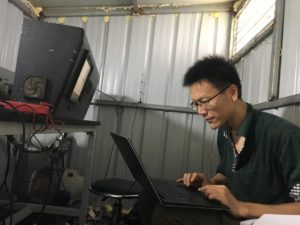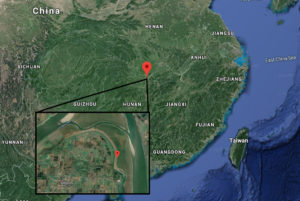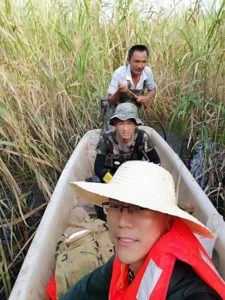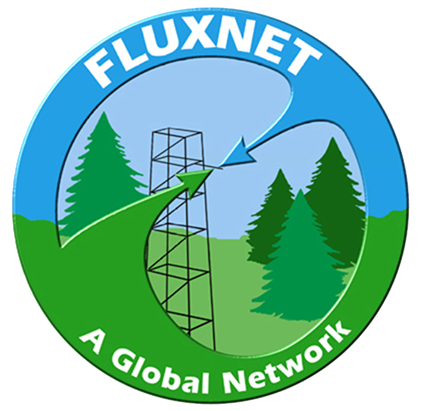Shenghua Gao wrapped up his appointment as a visiting scholar with the Center for Global Change and Earth Observations at Michigan State University June 28, 2019, after spending nine months with the Landscape Ecology and Ecosystem Science Lab (LEES), lead by Dr. Jiquan Chen. His appointment strengthened his analysis and offered him fresh perspectives on international collaboration. Here, he shares advice for other early-career scientists eager to experience a visiting scholar position.
Tell us a bit about yourself and your research as a visiting scholar.
“I am from the Research Institute of Forestry from the Chinese Academy of Forestry— a government research institute. I worked there as an assistant research fellow since 2015. In fact, I studied in the Chinese Academy of Forestry and after that, I got a job there.”
 “At the very beginning, when I was studying for my master’s degree, I wanted to study methane flux in a riparian forest plantations. During my doctoral study, I set up a new flux tower in a nearby wetland and reeds ecosystem. But unfortunately, it was destroyed. That field did not belong to us and someone changed the use of the site. As a result I changed my research to the poplar plantation focusing on the flux of carbon dioxide and water vapor (i.e., evapotranspiration). ”
“At the very beginning, when I was studying for my master’s degree, I wanted to study methane flux in a riparian forest plantations. During my doctoral study, I set up a new flux tower in a nearby wetland and reeds ecosystem. But unfortunately, it was destroyed. That field did not belong to us and someone changed the use of the site. As a result I changed my research to the poplar plantation focusing on the flux of carbon dioxide and water vapor (i.e., evapotranspiration). ”
“Since, I have been able to built a new flux tower in the [nearby] wetland to continue my study interest partly funded by NSFC (National Natural Science Foundation of China). I just set it up before I came here! It’s been running for nine months and my colleagues are helping me maintaining it right now.”

Study site of rotational poplar and wetland flux tower (29°28’48.0″N 113°03’00.0″E) in Junshan, Yueyang, Hunan, China.
“One of my goals is to systematically process the data of the poplar site. You know, my group in China focuses on forest ecological engineering. The poplar site is in fact a typical case of restoration of destroyed riparian zone of the Yangtze River. It has been running for ~14 years and covered every period of a forest plantation management, full-circle, including clear-cutting, reforestation, inter-cropping, inundation, insect burst, etc. .
“My final goal is to examine the contribution of this restoration on global warming mitigation and effect on regional water balance. I think it will be useful for the government when they make decision on regional ecological construction.”

What network of flux scientists are you connected with in China?
I found the United States – China Carbon Consortium (USCCC) when I was a masters student. That is where I learned the science of eddy covariance, because every year there is a training course before the meeting. We have a lot of professors to help young researchers with their work and to improve their skills. Each year, a group meeting is hosted by an academic institution in China, offering collaboration across flux tower sites, hands-on workshops, seminars and a field trip for attendees. The USCCC was founded by members who had their own sites. They came together to establish this group. After that, people without research sites could join. It is a really good group for young scientists.”
What did you gain from this international experience and how has it helped your research?
“It has been a wonderful experience for me to stay here and I can’t believe I got this opportunity. This is the first year our academy is supporting young scientists abroad and I was one of the two awarded.”
“I’m fortunate to have visited Michigan State University and LEES lab where I opened my mind intellectually. I talked with scholars, lab members and visited field work sites. Professor Chen advised me with observation equipment maintenance and repair as well as provided advice on my research and writing.”
Do you have any advice for other early-career scientists searching for visiting scholar positions?
“In China, there are ways to apply for these opportunities from the government… to help students study abroad. My opportunity was funded by my institution though. A more popular way is from the China Scholarship Council.”
“As far as advice, I first think they have to find a way to overcome being homesick and loneliness. In a completely different environment, they have to stay calm, focus on their research and communicate with others. Secondly, be aware and acknowledge the culture differences because there are many scholars from all around the world. The last, but the most important, is do be responsible for understanding and practicing the institution’s guidelines.”
“If one wants to improve his or her language, there are often free courses. For me, a community church and Michigan University both held courses for the international scholars. What a pity that I didn’t take advantage of these right away.”
What are your next steps once you return to the Chinese Academy of Forestry?
“When I get home I have a lot of fieldwork and data to process! But in the long term, I have to improve my research skills on theory. This is important for scholars.”
“I also want to make something really useful for the local government. With a recent government grant, I aim to develop a technique on managing timber plantations for increasing carbon sequestration. If it can aid a forest manager or to support a governmental decision, that will be exciting. In fact, there is great potential that Chinese man-made forests can mitigate climate change.”
